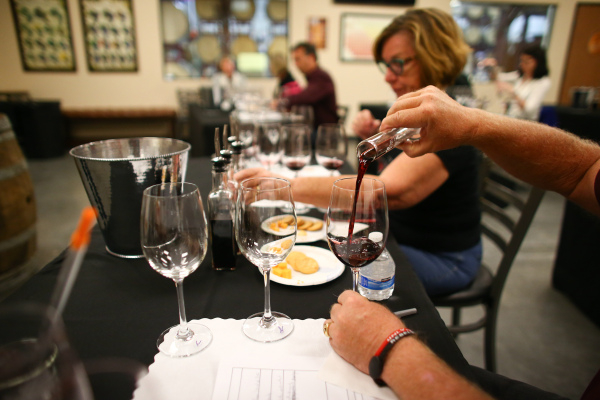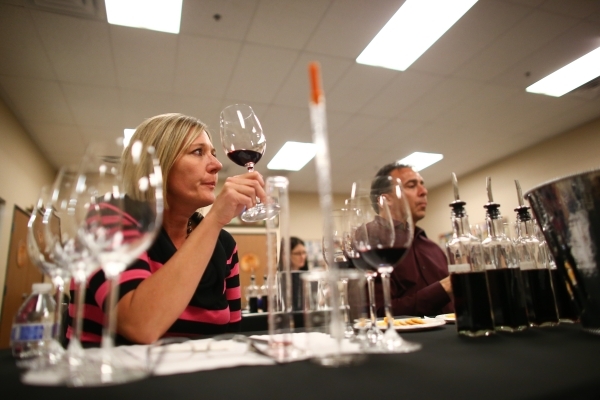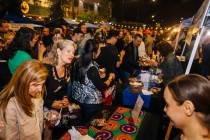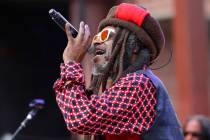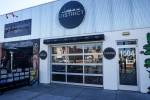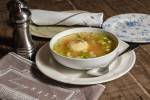Check out this wine blending class in Henderson — PHOTOS
K.J. Howe, whose business cards identify him as "professor of yeastology" at Grape Expectations Nevada School of Winemaking in Henderson, likens the process to putting together a good pasta sauce.
When it comes to wine, he said, single-varietal wines focus on a particular grape ("varietal" refers to grapes, such as cabernet sauvignon or pinot noir).
"But when you blend them together, it's like spaghetti sauce," Howe said. "Refrigerate it for a week and it all melds together and is wonderful on Saturday night."
Well, Howe wasn't advocating actually refrigerating wine in the making, or aging it for just a week. But the analogy was useful in describing the nuances of the blending process to a recent class at Grape Expectations.
The company began as a place where people could come to make wine, from start to finish. Grapes would be brought in once a year from California and participants would go through the whole process from crushing to bottling. A few years ago, the company added winemaking with Chilean grapes, because the California and Chile grape-harvest seasons are staggered and this way there could be two groups per year. Last February, Howe said, they started the blending classes, which are held during down times in the winemaking process.
"I was at Raymond Vineyards in Napa (Calif.), and they had a program to be a winemaker for a day, and they had a similar class," Howe said. "When I came back, I said, 'We've got to do this, because it's perfect for us.' "
So he went for another round at Raymond, along with Mike Schoenbaechler, Grape Expectations general manager and winemaker, and Chad Evans, head of production.
"We practiced on our winemakers and modified the class to fit what we're trying to do," Howe said. The first class last February was made up of corporate executives for McDonald's, who were in town for a convention. Overall, Howe said, about 70 percent of the participants have been Grape Expectations winemakers.
"We thought it would be just the opposite," he said.
On this January evening, six people are settled at the tables in the company's classroom. In front of each is a printed form. There are four wineglasses on their left and three on their right, four carafes of wine, a 100-milliliter graduated cylinder, a pipette for moving wine from bottle to cylinder and a crucible for mixing.
But before the action, there's an educational period. Howe explained that each winemaker has a stylistic approach to his or her wine, and that big wineries often have numerous blends. He talked about the five grapes that can be used in a Bordeaux blend (cabernet sauvignon, cabernet franc, merlot, petit verdot and malbec). He explained that the cabernet sauvignon grape was derived from the sauvignon blanc grape and cabernet franc, and now is the most widely planted grape in the world. He pointed out that by law, for a wine to be labeled, say, "cabernet sauvignon," it need contain only a certain percentage of that varietal. He showed them a chart of more than 140 varietals grown in the world, which indicated such qualities as tannin ("It makes your mouth pucker"), acidity ("It makes your mouth water"), color, etc. He said that in the favorite wine of one participant, The Prisoner Zinfandel, the zinfandel grape is blended with seven other varietals, making it "one of the most complex wines made."
And then it was time to get started. Howe told the students to pick up the first of the wines in front of them — unoaked cabernet sauvignon and oaked cabernet sauvignon, merlot and cabernet franc — and pour 40 milliliters into the first of the four glasses on the left. He described the process he uses to evaluate a wine and asked them to jot down things they perceived in each.
Along the way, Howe did much to demystify wine.
"Everybody's palate in this room is different," he said. "It's what you perceive individually that we need to know, not what any expert says. Don't worry about the descriptives, and if you don't perceive anything, that's OK."
Between varietals, Howe would say, "I've got to read to you what the experts say" before launching into a long list of descriptives, many of which bordered on the comical. The difference between "damp earth" and "potting soil"? Who knows?
After evaluating all four, the students were invited to come up with their own blends. After the class was over, their blend would be bottled so they could take it home.
Staffer Dave Belcher told them that as they started to blend, it was a good idea to go back and taste the original.
"When you add 1 percent to 2 percent," Howe said, "you'd be surprised the difference you make."
"You definitely want to go home with something you like," added staff member Julie Jackson, "so do another one if you don't like it."
At times, things got a little heated.
"Don't look at what I put in it," Kim Kowalczik warned her husband.
"We actually have had some arguments in this room," Howe said.
In the end, some of them liked their wines so much that they bought bottles in addition to the one included with the class.
Kowalczik said the class was a gift to her and her husband from some employees, who also participated. She said they'd become more interested in wine in the past couple of years, and that she thought she'd learned from the class.
"I have," she said, "become a wine geek."
Contact Heidi Knapp Rinella at Hrinella@reviewjournal.com. Find more of her stories at www.reviewjournal.com, and follow @HKRinella on Twitter.



